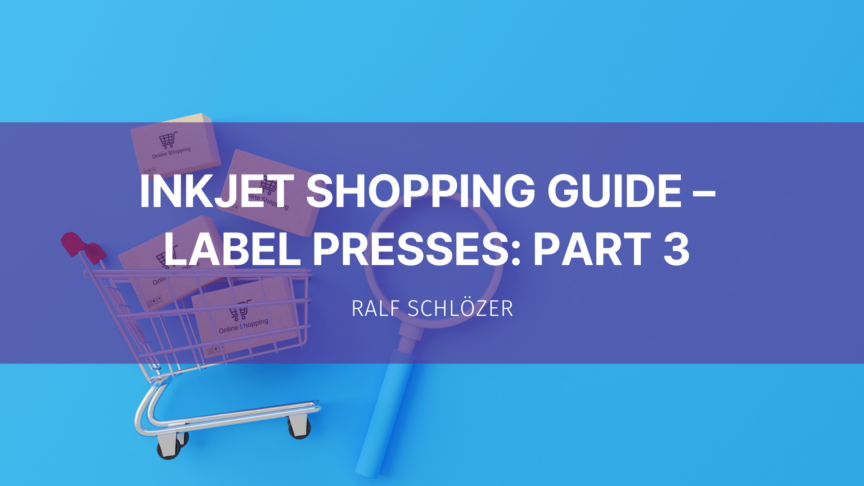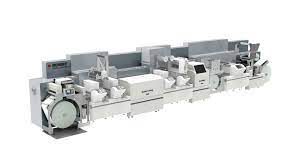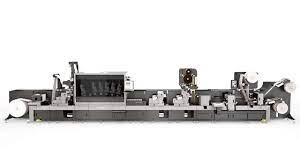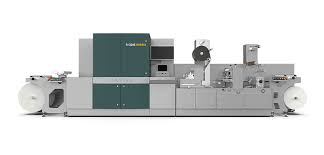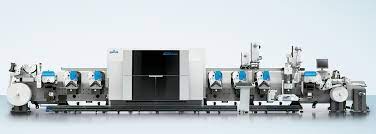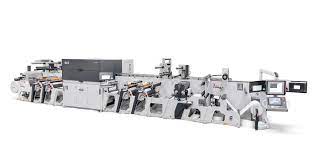Part 1 and 2 of this series on inkjet label presses considered entry level and mid to high level productivity respectively. We noted that the lines between these categories are not very distinct, so it is worthwhile to review the whole series. Primarily in the high end of the market are found hybrid inkjet / analogue presses that can provide economic and productivity benefit over either stand-alone technology in the right scenario. This article covers current hybrid offers.
The first part of the article on entry-level printers and general selection criteria can be found here.
The second on mid-high level presses and criteria can be found here.
Defining hybrid inkjet label presses
Hybrid presses combine inkjet and analogue technology. The combination can be used to print static portions in flexo, using lower-cost flexo ink, and only the variable portions or full colour images are printed in inkjet. Sometimes there are no extra inkjet colours available beyond CMYK, as those can be printed in flexo. If mostly large areas are printed in inkjet, the approach loses appeal however, as in addition to the higher inkjet ink costs plates are needed as well, including change-over time and waste. The ideal market for hybrid is versioning when large parts of a label remain static.
Initially, inkjet units were added onto conventional flexo press lines, making multiple flexo units and inline finishing possible. The latest models have a more modular design with a range of modules optimised for the analogue – digital interplay. Those presses are also available as stand-alone digital solutions– effectively a configuration with unwind, rewind and the inkjet print module in the middle.
Hybrid presses have the option for inline finishing, which can make the whole line very efficient – if change-overs do not require too much downtime in the finishing portion.
Especially suppliers of analogue label presses offer hybrid solutions and all major suppliers do have offerings.
Bobst launched the Digital Master 340/510 in 2022, replacing the Master DM-series with a fully modular and digital-optimised concept. Gallus, a subsidy of Heidelberger Druckmaschinen, is a long-standing supplier of flexo presses as well. The company launched the Labelfire almost 10 years ago. Nilpeter is currently offering the Panorama press, with a new hybrid press developed in conjunction with Screen to be announced at LabelExpo 2023. Another partnership is the XJet from Omet, where Durst is supplying the imaging unit. Canon joined the array of analogue label press manufacturers when acquiring Edale in 2022 and has the LabelStream 4000 on offer in this segment.
The print speeds in the table below are based on using the inkjet unit. If printing purely analogue, most presses can run a lot faster. The length of the printer represents a base version, with a full-blown line with flexo units, finishing, and embellishment modules being much longer.
|
Vendors & Models |
Max Print speed |
Inkjet imaging technology |
Resolution & Number of colours |
Max Print width & Substrate thickness |
Printer length |
Availability |
|
Bobst Digital Master 340/510
|
up to 100 m/min (330 fpm) |
UV inks on Dimatix samba inkjet heads |
up to 1200 x 1200 dpi with grey levels 6 colours plus white |
340 or 510 mm print width |
5.6 m |
Global |
|
Canon LabelStream 4000
|
up to 75 m/min (250 fpm) |
UV inks on Xaar inkjet heads |
up to 720 x 1080 dpi with grey levels 6 colours inc white |
330 or 410 mm print width 40-600µ thickness (digital print) |
Global |
|
|
Dantex Pico 1200 hybrid
|
up to 75 m/min (250 fpm) |
UV inks |
up to 600 x 600 dpi with grey levels CMYK plus white & OGV |
254 or 330 mm print width 50-300µ thickness |
US and several European countries |
|
|
Gallus Labelfire
|
up to 70 m/min (230 fpm) |
UV inks on Dimatix samba inkjet heads |
up to 1200 x 1200 dpi with grey levels 7 colours plus white |
340 mm print width 50-300µ thickness |
11.5 m |
Global |
|
JETSCI Colornovo Hybrid+
|
up to 50 m/min (165 fpm) |
UV inks |
up to 600 x 1200 dpi up to 7 colours |
324 mm print width 20-200µ thickness |
East Asia and select other countries |
|
|
Nilpeter Panorama
|
up to 50 m/min (165 fpm) |
UV inks |
up to 600 x 600 dpi with 4 grey levels CMYK plus white |
330 mm print width |
Global |
|
|
Omet XJet
|
up to 100 m/min (330 fpm) |
UV inks on Dimatix samba inkjet heads |
up to 1200 x 1200 dpi with 4 grey levels CMYK plus 4 colours |
330/420/510 mm print width |
Global |
Build your own hybrid solution
Another option is to integrate an inkjet printbar with an existing flexo press to create a hybrid solution. A large range of vendors are offering different types of imprinting units or printbars. For example, Colordyne is offering an UV inkjet printbar. The engine can be mounted on a flexo press that and has a unique job-chaining software. Domino is not offering a hybrid press under its own brand name but is cooperating with many flexo press suppliers. Based on the standalone printers, N610i and N730i integration modules specifically for label print are available. Soon even a retrofittable module will be launched. According to Domino this market continues to grow as hybrids continue to be a growing trend. It now represents roughly 50% of new installations today. There are more suppliers including Memjet and Fujifilm. Most recently Xaar launched the Versatex printbar specifically for label and packaging printing.
Finding the right fit
There are so many options for inkjet label printing that this series had to be broken into multiple parts. There will continue to be new players and new options from existing OEMs entering the market. Solutions for integrators such as print bars are expanding the market even further. The choices can be overwhelming, but ultimately choice is good for buyers.
As noted previously, our goal is to offer a high-level overview and comparison of base specifications. There are many other factors vital in choosing the right device such as price, ease of operation and front-end capabilities that are best explored in person at a trade show or OEM showroom.
If you have products or comments to add, please contact us.

